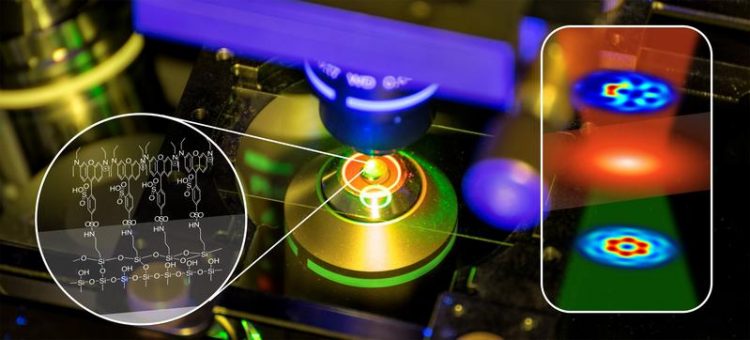New method for the measurement of nano-structured light fields

A monolayer of organic molecules is placed in the focused light field and replies to this illumination by fluorescence, embedding all information about the invisible properties. Credit: Pascal Runde Usage Restrictions: Please use this picture only in connection with the press release.
Structured laser light has already opened up various different applications: it allows for precise material machining, trapping, manipulating or defined movement of small particles or cell compartments, as well as increasing the bandwidth for next-generation intelligent computing.
If these light structures are tightly focused by a lens, like a magnifying glass used as burning glass, highly intense three-dimensional light landscapes will be shaped, facilitating a significantly enhanced resolution in named applications. These kinds of light landscapes has paved the way to pioneering applications as Nobel prize awarded STED microscopy.
However, these nano-fields itself could not be measured yet, since components are formed by tight focusing which are invisible for typical measurement techniques.
Up to now, this lack of appropriate metrological methods has impeded the breakthrough of nano-structured light landscapes as a tool for material machining, optical tweezers, or high-resolution imaging.
A team around physicist Prof. Dr. Cornelia Denz of the Institute of Applied Physics and chemist Prof. Dr. Bart Jan Ravoo of the Center for Soft Nanoscience at the University of Münster (Germany) successfully developed a nano-tomographic technique which is able to detect the typically invisible properties of nano-structured fields in the focus of a lens – without requiring any complex analysis algorithms or data post-processing.
For this purpose, the team combined their knowledge in the field of nano-optics and organic chemistry to realize an approach based on a monolayer of organic molecules. This monolayer is placed in the focused light field and replies to this illumination by fluorescence, embedding all information about the invisible properties.
By the detection of this reply the distinct identification of the nano-field by a single, fast and straightforward camera image is enabled. “This approach finally opens the till now unexploited potential of these nano-structured light landscapes for many more applications,” says Cornelia Denz, who is heading the study. The study has been published in the journal “Nature Communications”.
Funding:
The study received financial support from the Cells-in-Motion Cluster of Excellence and the TRR 61 “Multilevel-molekulare Assemblate: Struktur, Dynamik und Funktion”, both at Münster University.
Prof. Cornelia Denz, Münster University
phone: +49 251 83 33517
denz@uni-muenster.de
E. Otte et al. (2019): Polarization nano-tomography of tightly focused light landscapes by self-assembled monolayers. Nature Communications; DOI: 10.1038/s41467-019-12127-3
https://www.nature.com/articles/s41467-019-12127-3 Original publication in “Nature Communications”
https://www.uni-muenster.de/Physik.AP/Denz/en/index.html Research group Prof. Cornelia Denz at Münster University
https://www.uni-muenster.de/Chemie.oc/ravoo/index.html Research group Prof. Bart Jan Ravoo at Münster University
Media Contact
All latest news from the category: Life Sciences and Chemistry
Articles and reports from the Life Sciences and chemistry area deal with applied and basic research into modern biology, chemistry and human medicine.
Valuable information can be found on a range of life sciences fields including bacteriology, biochemistry, bionics, bioinformatics, biophysics, biotechnology, genetics, geobotany, human biology, marine biology, microbiology, molecular biology, cellular biology, zoology, bioinorganic chemistry, microchemistry and environmental chemistry.
Newest articles

A universal framework for spatial biology
SpatialData is a freely accessible tool to unify and integrate data from different omics technologies accounting for spatial information, which can provide holistic insights into health and disease. Biological processes…

How complex biological processes arise
A $20 million grant from the U.S. National Science Foundation (NSF) will support the establishment and operation of the National Synthesis Center for Emergence in the Molecular and Cellular Sciences (NCEMS) at…

Airborne single-photon lidar system achieves high-resolution 3D imaging
Compact, low-power system opens doors for photon-efficient drone and satellite-based environmental monitoring and mapping. Researchers have developed a compact and lightweight single-photon airborne lidar system that can acquire high-resolution 3D…





















